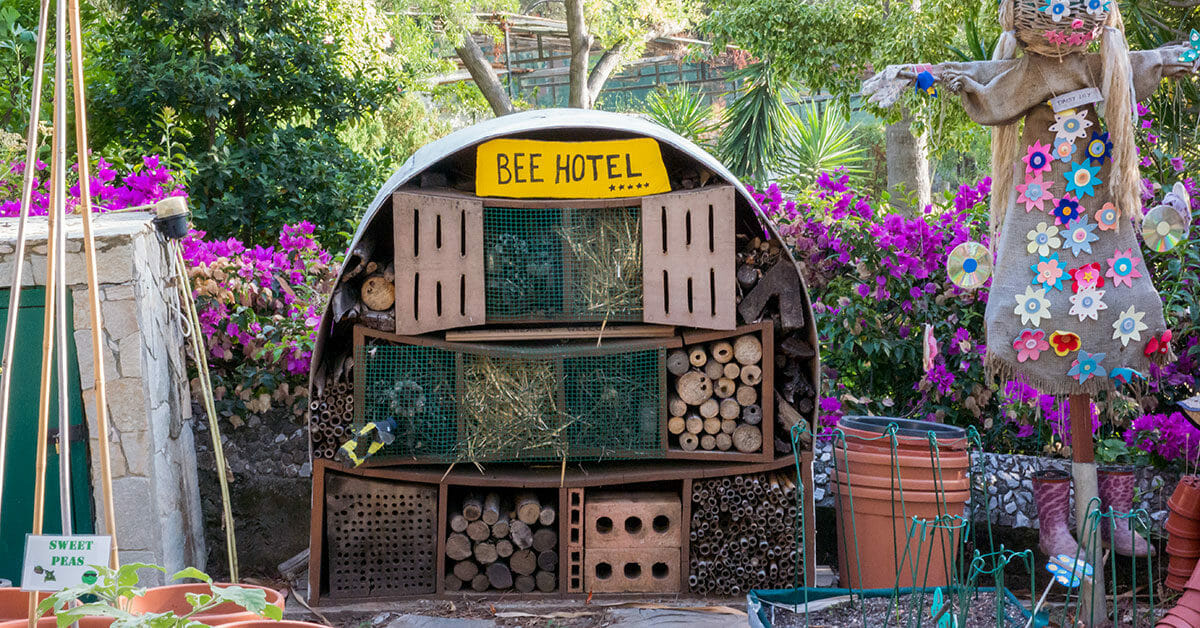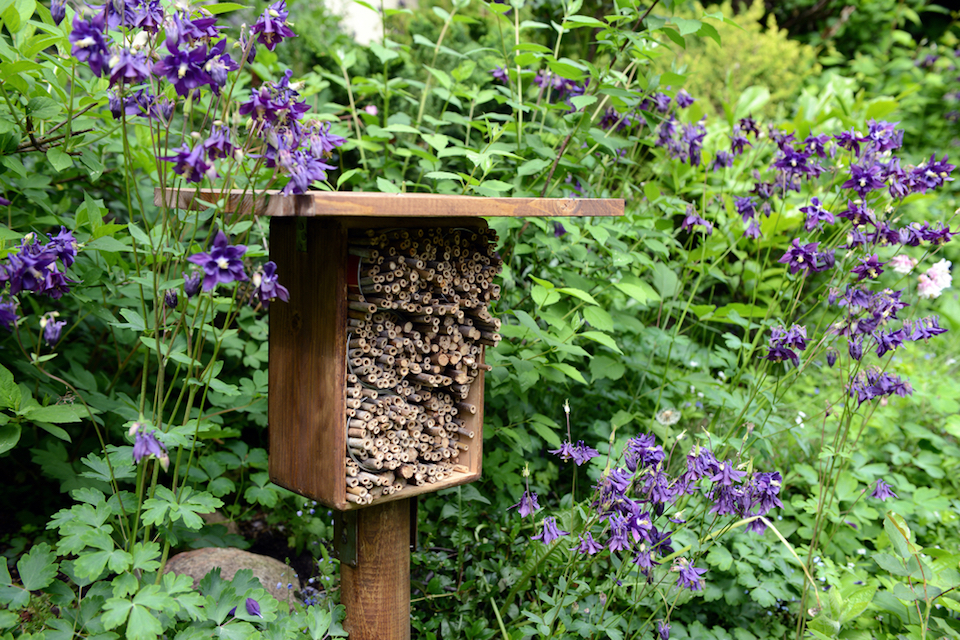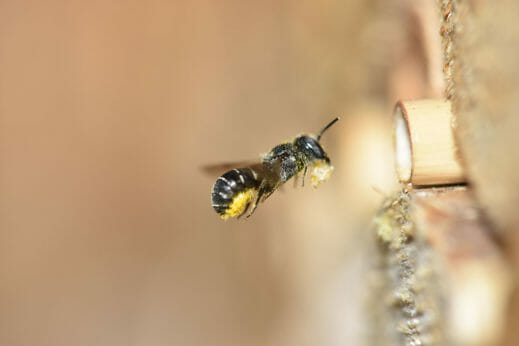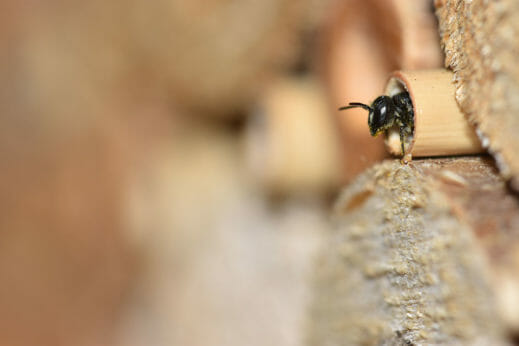Weekend Project: How-To Build a Native Bee Hotel
Honeybees get all the attention, but these unsung workhorses deserve a place in your garden, too.
Weekend Project: How-To Build a Native Bee Hotel
Honeybees get all the attention, but these unsung workhorses deserve a place in your garden, too.

Many of these so-called “solitary bees,” which include mason bees, leafcutter bees, and carder bees, look more like flying ants than fuzzy yellow bees, but they’re valuable pollinators just the same. The traditional hive boxes used to house honeybees do nothing to attract native bees to your garden, but these unsung heroes will happily take up residence in a “bee hotel,” where each can have a private room of their own.
“Communal bees” would be a more apt name for native bees, as most like to live in close proximity to one another, just not in the highly social confines of a hive (some of us can surely relate). Instead, they look for narrow tubular spaces, such as the hollow center of a reed or a crevice in a rock wall, where they can safely lay eggs and incubate their young. It isn’t easy for a tiny bee to find the perfect home, especially in the city, so if you create the ideal living space – an easy hour-long project, requiring little more than a few scraps of lumber, some screws, and an electric drill – they will come in droves.
Step One: Build a Frame
The exterior walls of a bee hotel can be made with almost any lumber scraps you happen to have lying around. Freshly purchased pressure-treated wood should be avoided, though, as the chemicals inside will deter the bees. Older, weathered pressure-treated lumber is fine.
You can build the hotel as big as you want, and in any shape you want, though a rectangle about the size of a typical birdhouse (roughly 8” x 12”) is a common and easy to construct design. The only real requirement, in terms of dimensions, is that the frame be approximately 6 to 8 inches deep. 1” x 8” lumber (which is actually ¾” by 7 ¼” wide) is ideal.
The frame must be enclosed at the back – lightweight plywood cut to size is perfect for this part – and open in front. The roof must be sloped to shed rain and must extend at least 2 inches over the front. You can use wood again, or, if you’d like, tack on a piece of corrugated metal roofing for a cute, barn-like bee hotel.
The wooden frame may be left unfinished, coated with an exterior wood sealant to protect it from the elements, or jazzed up with colorful paint. Just know that the smell of paint and sealant is likely to deter bees for at least a few weeks until it wears off.

Step Two: Add “Rooms”
The hotel “rooms” are nothing more than holes drilled into blocks of wood. You can use random scraps of lumber or even small logs cut from tree branches. Whatever materials you use, they should all be cut to the same length, which is determined by the depth of the frame (a minimum of 6 inches).
Native bees vary greatly in size; the bigger the bee, the larger the diameter and greater depth they require for their nest hole. Drill holes ranging from 1/8” to ½” in diameter into the end of each block or log, spacing them about ½” to ¾” apart. Holes larger than ¼” should be 5” to 6” deep, while holes ¼” or smaller should be 3” to 5” deep. Make as many hole-filled blocks as will fit in the frame, and then smooth out the openings with sandpaper to remove any sharp splinters left by the drill.
You may also fill portions of the frame with small-diameter pieces of bamboo, hollow reeds, or plastic tubing cut to the same length as the wooden blocks.


Step Three: Mount the Hotel
Mount your bee hotel on a fence post, exterior wall, or any other vertical surface with a couple of screws through the rear wall. It should be roughly chest high and facing south if possible, so it warms up earlier in spring and stays warm later in fall, extending the egg-laying season for the resident bees. Stack the blocks, bamboo, and any other bee rooms you’ve created inside the frame with the hole openings facing out.
Female bees will construct individual chambers throughout each hole with mud, chewed up plant material, and other substances, depending on the species. A single egg is deposited in each chamber, along with a bit of pollen for the baby bees to eat after they hatch. Once a tube is filled, it will be sealed off at the opening to prevent moisture and predatory insects from entering.
The hatched bees remain inside the sealed tubes through the winter, emerging as adults in spring when warm weather returns. After all the sealed openings have been broken by the exiting bees, bee experts recommend removing the old “rooms” and building a new set each year as a precaution against transmitting diseases from one generation to the next.
SaveSave
Follow us
This work is licensed under a Creative Commons Attribution-NoDerivatives 4.0 International License.
Want to republish a Modern Farmer story?
We are happy for Modern Farmer stories to be shared, and encourage you to republish our articles for your audience. When doing so, we ask that you follow these guidelines:
Please credit us and our writers
For the author byline, please use “Author Name, Modern Farmer.” At the top of our stories, if on the web, please include this text and link: “This story was originally published by Modern Farmer.”
Please make sure to include a link back to either our home page or the article URL.
At the bottom of the story, please include the following text:
“Modern Farmer is a nonprofit initiative dedicated to raising awareness and catalyzing action at the intersection of food, agriculture, and society. Read more at <link>Modern Farmer</link>.”
Use our widget
We’d like to be able to track our stories, so we ask that if you republish our content, you do so using our widget (located on the left hand side of the article). The HTML code has a built-in tracker that tells us the data and domain where the story was published, as well as view counts.
Check the image requirements
It’s your responsibility to confirm you're licensed to republish images in our articles. Some images, such as those from commercial providers, don't allow their images to be republished without permission or payment. Copyright terms are generally listed in the image caption and attribution. You are welcome to omit our images or substitute with your own. Charts and interactive graphics follow the same rules.
Don’t change too much. Or, ask us first.
Articles must be republished in their entirety. It’s okay to change references to time (“today” to “yesterday”) or location (“Iowa City, IA” to “here”). But please keep everything else the same.
If you feel strongly that a more material edit needs to be made, get in touch with us at [email protected]. We’re happy to discuss it with the original author, but we must have prior approval for changes before publication.
Special cases
Extracts. You may run the first few lines or paragraphs of the article and then say: “Read the full article at Modern Farmer” with a link back to the original article.
Quotes. You may quote authors provided you include a link back to the article URL.
Translations. These require writer approval. To inquire about translation of a Modern Farmer article, contact us at [email protected]
Signed consent / copyright release forms. These are not required, provided you are following these guidelines.
Print. Articles can be republished in print under these same rules, with the exception that you do not need to include the links.
Tag us
When sharing the story on social media, please tag us using the following: - Twitter (@ModFarm) - Facebook (@ModernFarmerMedia) - Instagram (@modfarm)
Use our content respectfully
Modern Farmer is a nonprofit and as such we share our content for free and in good faith in order to reach new audiences. Respectfully,
No selling ads against our stories. It’s okay to put our stories on pages with ads.
Don’t republish our material wholesale, or automatically; you need to select stories to be republished individually.
You have no rights to sell, license, syndicate, or otherwise represent yourself as the authorized owner of our material to any third parties. This means that you cannot actively publish or submit our work for syndication to third party platforms or apps like Apple News or Google News. We understand that publishers cannot fully control when certain third parties automatically summarize or crawl content from publishers’ own sites.
Keep in touch
We want to hear from you if you love Modern Farmer content, have a collaboration idea, or anything else to share. As a nonprofit outlet, we work in service of our community and are always open to comments, feedback, and ideas. Contact us at [email protected].by Brian Barth, Modern Farmer
May 16, 2018
Modern Farmer Weekly
Solutions Hub
Innovations, ideas and inspiration. Actionable solutions for a resilient food system.
ExploreExplore other topics
Share With Us
We want to hear from Modern Farmer readers who have thoughtful commentary, actionable solutions, or helpful ideas to share.
SubmitNecessary cookies are absolutely essential for the website to function properly. This category only includes cookies that ensures basic functionalities and security features of the website. These cookies do not store any personal information.
Any cookies that may not be particularly necessary for the website to function and are used specifically to collect user personal data via analytics, ads, other embedded contents are termed as non-necessary cookies.